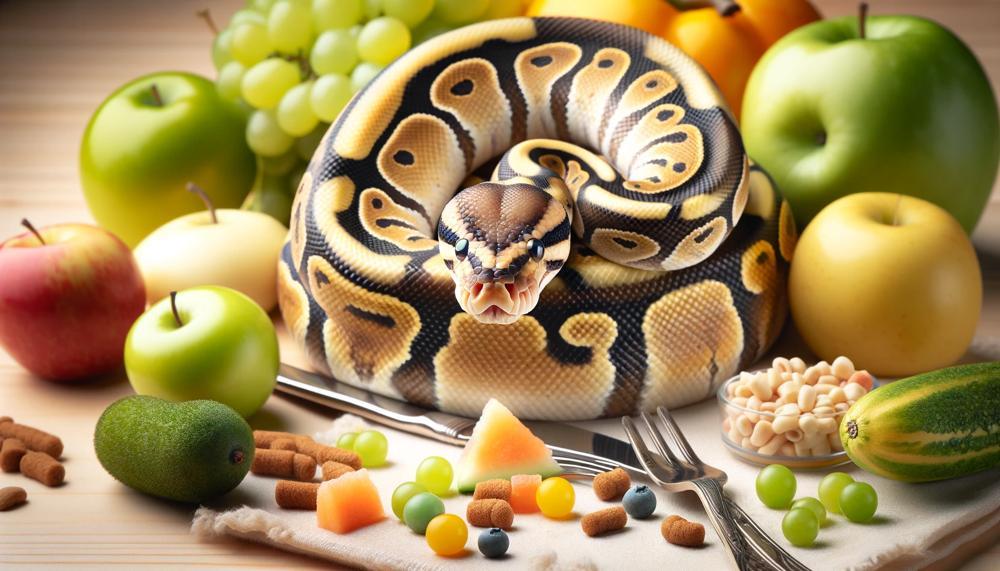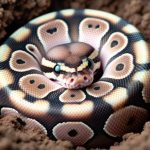Are you ready to discover the remarkable capabilities of a creature that can survive for weeks, even months, without food? Look no further than the ball python – a captivating serpent that has captured the hearts of reptile enthusiasts and inquisitive minds alike.
But what sets this species apart from other snakes? It’s their incredible ability to endure extended periods without sustenance. Here are some intriguing points to pique your interest:
- Native to sub-Saharan Africa, these snakes are also known as royal pythons.
- In their natural habitat, they typically prey on small mammals such as rodents. However, in captivity, they can thrive on a diet of frozen or thawed mice or rats.
- Thanks to their sluggish metabolism, ball pythons can go up to six months without eating.
- This adaptation allows them to survive in harsh environments with limited food sources.
- During this time, they may experience weight loss and become more lethargic – but rest assured, it is completely normal for them.
- Their ability to sustain themselves for extended periods makes them low-maintenance pets compared to other reptiles.
So if you’re seeking a unique pet that won’t require daily feedings, consider welcoming a ball python into your family. Keep reading for more fascinating facts about these amazing creatures.
Contents
- 1 How Long Can a Ball Python Go Without Eating
- 2 How Do Ball Pythons Survive Without Food For So Long
- 3 How Long Can a Baby Ball Python Stay Hungry
- 4 How Often Should You Feed Your Adult Ball Python
- 5 How Often Should You Feed Baby Ball Pythons
- 6 Why Your Ball Python May Not Want to Eat
- 7 What To Do If Your Ball Python Won’t Eat
- 8 Conclusion
How Long Can a Ball Python Go Without Eating
On average, a ball python can survive for up to half a year without eating, but prolonged periods of fasting can have detrimental effects on their health. However, there are various factors that can influence this time frame. These include the snake’s age, size, and feeding schedule. Juvenile ball pythons should be fed twice a week, while adult snakes only require one full meal per week or every other week. This means that younger pythons may have a shorter window of time in which they can go without food compared to their older counterparts.
Furthermore, the method of feeding can also play a role in how long a ball python can last without eating. In captivity, these snakes are typically fed frozen or live mice, with some debate among owners regarding which is more beneficial. It’s important to maintain consistency in feeding method for these snakes, as sudden changes may cause them to reject food.
It’s crucial to note that although snakes have slow metabolisms and are able to survive extended periods without food, this should not be practiced in captivity as it can lead to various health issues. To prevent these issues, owners must ensure their snake is provided with proper heat and humidity levels and be willing to try different feeding techniques if their python refuses to eat.
How Do Ball Pythons Survive Without Food For So Long

Ball pythons have various physical and behavioral adaptations that enable them to survive for extended periods without food
These unique traits include a sluggish metabolism, efficient energy storage, and changes in behavior.
A Slow Metabolism:
Ball pythons boast a slow metabolism, which means they require less food compared to other snake species. This adaptation is a result of their natural habitat where food may not always be accessible. As a result, they have evolved to conserve energy and survive for longer periods without eating.
Furthermore, this slow metabolism helps them maintain their body temperature and energy levels during times of food scarcity.
Efficient Energy Storage:
Another key factor that contributes to their ability to survive without food is their efficient energy storage. Ball pythons can store fat reserves in their bodies, which serve as a source of energy when food is scarce.
This mechanism helps them maintain their body weight and overall health during times when food is not readily available.
Behavioral Changes:
During periods of food scarcity, ball pythons exhibit behavioral changes to conserve energy. They become less active and move around less, which helps them preserve energy and survive for longer periods without eating. They may also seek shelter in their burrows or hiding places to conserve heat and energy.
Aside from these adaptations, ball pythons also possess a robust immune system that allows them to fight off infections and diseases that may arise during times of food scarcity. They are also able to adjust their feeding schedule based on their environment, allowing them to survive in different habitats with varying food availability.
How Long Can a Baby Ball Python Stay Hungry
Based on research, the average duration a baby ball python can go without eating before it becomes a concern for their health and well-being is usually around 2 weeks.
However, this timeline may vary depending on the individual snake’s health and environmental factors.
| Factors that may affect how long a baby ball python can stay hungry: | Impact on hunger timeline: |
| The snake’s health | A sick or weak baby ball python may not be able to go as long without eating compared to a healthy snake. If you notice any signs of illness in your snake, such as lethargy or weight loss, it is important to consult with a veterinarian. |
| Temperature and humidity levels | Ball pythons are highly sensitive to changes in temperature and humidity. If these levels are not within the appropriate range, they may refuse to eat or have difficulty digesting their food. |
| Size of the snake | Baby ball pythons are smaller and have less body fat than adult ball pythons. This means they may not be able to go as long without eating before it becomes a concern for their health and well-being. |
| Recent feeding schedule | If a baby ball python has recently eaten, they may not be hungry for longer than usual. It is important to keep track of when your snake last ate to determine if their hunger strike is due to their natural behavior or another factor. |
| Stress or changes in environment | Stress can cause a baby ball python to refuse food, such as moving to a new enclosure or introducing new tank mates. It is important to give your snake time to adjust and provide a calm and comfortable environment. |
If your baby ball python goes without eating for more than 2 weeks, it may be a cause for concern. In this case, it is recommended to seek advice from a reptile veterinarian for further guidance. It is crucial to address any potential health issues or environmental factors that may be causing your snake to refuse food.
How Often Should You Feed Your Adult Ball Python
Feeding an adult ball python requires careful consideration of several factors to determine the most suitable feeding schedule. Unlike younger snakes, adult ball pythons tend to eat less frequently, but their feeding schedule can be influenced by various elements such as size, health, temperature, and stress.
Frequency of Feeding:
The frequency of feeding for adult ball pythons varies depending on their age and growth. As a general guideline, they should be fed every 10-14 days.
However, this may differ for individual snakes and their specific needs. It is crucial to monitor your snake’s weight and adjust the feeding schedule accordingly.
Size Matters:
The size of your ball python can also impact their feeding frequency. Larger snakes may require bigger prey items and may need to be fed less often.
Conversely, smaller snakes may need to be fed more frequently with smaller prey items.
Health Check:
A healthy ball python typically has a good appetite and eats regularly. If your snake is not eating or has a reduced appetite, it could be a sign of underlying health issues.
In such cases, it is essential to seek advice from a reptile veterinarian to address any potential health concerns.
Temperature Check:
Temperature plays a vital role in a ball python’s digestion and metabolism. If the temperature is too low, their digestion will slow down, and they may not feel hungry. Therefore, providing an appropriate temperature gradient in their enclosure and warming up their prey items before feeding is essential for proper digestion.
Stress Check:
Stress can also affect a ball python’s appetite and feeding schedule. Changes in their environment, handling, or other factors can cause stress and lead to a reduced appetite.
It is crucial to provide a secure and comfortable environment for your snake to reduce stress and promote healthy eating habits.
In conclusion, while adult ball pythons typically have a feeding schedule of every 10-14 days, it is vital to consider their individual needs and adjust accordingly.
Factors such as size, health, temperature, and stress can all affect their appetite and feeding frequency.
How Often Should You Feed Baby Ball Pythons
When it comes to feeding baby ball pythons, it’s crucial to keep in mind that they require more frequent feedings compared to adults. This is due to their high metabolic rate and rapid growth. In general, it’s recommended to feed them every 5-7 days to ensure proper growth and development. However, the frequency of feedings may vary depending on individual needs and factors such as size, health, and appetite.
First and foremost, the type and size of prey items must be considered. Baby ball pythons should be fed smaller mice or rats, while sub-adults and adults can consume larger prey items. It is crucial to offer appropriately sized food to avoid regurgitation. Furthermore, the age and size of the snake also play a significant role in determining the frequency of feedings.
Another important aspect to consider is the signs of hunger in the snake. If the snake is constantly searching for food or appears restless, this may indicate that it needs to be fed more frequently or with larger prey items.
To ensure a smooth transition, it is recommended to start introducing rats early on, as most ball pythons become accustomed to eating only one type of prey and may have difficulties switching later on. This can also help with offering larger meals as the snake grows.
In addition to prey items, the feeding environment also plays a vital role. For safety reasons, frozen/thawed mice or rats are preferred over live prey. If using frozen prey, ensure that it is properly thawed before offering it to your snake.
The temperature and stress level of the snake can also impact its feeding schedule. If their environment is too cold or if they are under stress, snakes may refuse food. Providing a warm and comfortable environment can help stimulate their appetite.
Lastly, it is essential to monitor the snake’s weight and adjust feeding amounts accordingly. It is recommended to weigh both the snake and the food item for accurate feeding amounts.
Why Your Ball Python May Not Want to Eat
Some common reasons for a ball python’s refusal to eat include parasites and disease, stress, changes in temperature, seasonal fluctuations, picky eating habits, and shedding.
Parasites and disease can greatly impact a ball python’s desire to eat. These issues can lead to digestive problems and discomfort, causing a snake to avoid food altogether. If you suspect your snake may be suffering from parasites or a disease, it is imperative to seek treatment from a reptile veterinarian.
Stress can also play a significant role in a ball python’s appetite. This can be triggered by changes in their environment, excessive handling, or cohabitation with other snakes. It is important to create a calm and stable environment for your snake to minimize stress levels.
Temperature changes can also affect a ball python’s willingness to eat. These snakes require a warm basking spot with a temperature of 88-92°F and a cooler side of the enclosure with a temperature of 75-80°F. If the temperatures are too low or too high, it can disrupt their digestion and decrease their interest in food.
Seasonal changes can also have an impact on a ball python’s appetite. In the wild, these snakes would experience seasonal fluctuations which would affect their feeding patterns. This can still occur in captivity, causing snakes to go off feed for weeks or even months at a time.
Some ball pythons may be selective eaters and have preferences for certain types of prey over others. This can make it challenging for owners to find the right food that will entice their snake to eat.
Lastly, shedding can also lead to a loss of appetite in ball pythons. During this time, their skin may appear dull and they may seem less active. It is normal for snakes to refuse food during the shedding process, and they will typically resume eating once they have shed their entire skin.
In general, a ball python can go without eating for several weeks without any major concerns. However, if they continue to refuse food for extended periods of time, it is important to consult a veterinarian to rule out any underlying health issues. As a general guideline, if your snake has not eaten for more than 4-6 weeks, it is recommended to seek professional advice.
What To Do If Your Ball Python Won’t Eat
Ball pythons may sometimes have a reduced appetite and stop eating. If your ball python is not eating, there are several steps you can take to address the issue and ensure their health and well-being.
- Check for underlying health issues: Before trying any solutions, make sure your snake is not suffering from any illness or health problems. Look for signs of weight loss, respiratory issues, or abnormal behavior that may indicate a health concern.
- Reduce stress: Stress is a common reason for ball pythons to stop eating. Ensure their environment is calm and free of disruptions. Avoid handling them too much and provide plenty of hiding spots in their enclosure.
- Monitor temperature and humidity levels: Proper heating and humidity are crucial for digestion in ball pythons. Make sure their enclosure is at the appropriate temperature and humidity levels.
- Be aware of seasonal changes: Ball pythons may go through periods of reduced appetite during seasonal changes or breeding season. This is normal, and they will resume eating when ready.
- Experiment with different prey and feeding methods: Some ball pythons can be picky eaters, so try offering different types of prey or changing up the feeding method. For example, some snakes may prefer live prey over frozen-thawed.
- Maintain a clean enclosure: A dirty enclosure can also affect a ball python’s appetite. Make sure to clean their enclosure after every shed and defecation.
- Be patient and avoid forcing: It’s important to be patient with your snake and not force them to eat. Most ball pythons will resume eating on their own when they are ready.
Conclusion
In conclusion, the ball python is a truly remarkable creature that has captured the hearts of reptile enthusiasts and inquisitive minds alike. This species, also known as royal pythons, possess an incredible ability to endure extended periods without food. Originating from sub-Saharan Africa, these snakes typically prey on small mammals but can thrive on a diet of frozen or thawed mice or rats in captivity. Thanks to their sluggish metabolism, ball pythons can go up to six months without eating, making them low-maintenance pets compared to other reptiles.
Their remarkable survival skills are attributed to various physical and behavioral adaptations such as a slow metabolism, efficient energy storage, and changes in behavior. These adaptations allow them to sustain themselves for extended periods without food. However, it is important for owners to closely monitor their snake’s eating habits and provide appropriate care to promote their overall health and well-being.
For baby ball pythons, the average duration they can go without eating before it becomes a concern for their health is around two weeks. This timeline may be affected by factors such as age, size, health, temperature, and stress levels. As for adult ball pythons, their feeding schedule may vary depending on factors like size, regular health check-ups, temperature checks, and stress levels.
In summary, the ball python’s unique capabilities make them fascinating creatures that are worth discovering. Whether you’re considering welcoming one into your family or simply intrigued by these captivating serpents – there’s no denying their impressive ability to survive for extended periods without sustenance.






